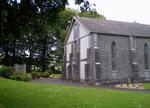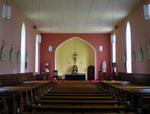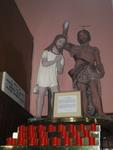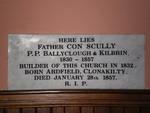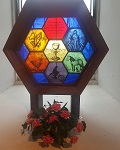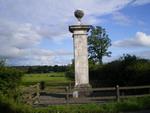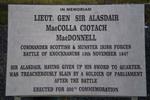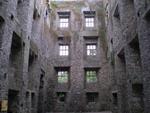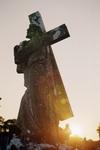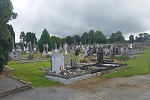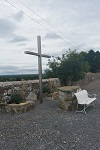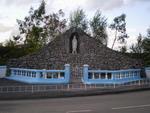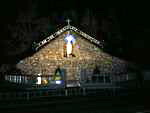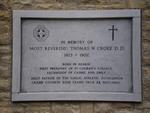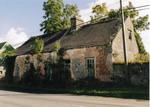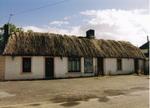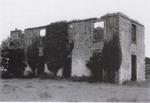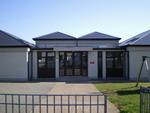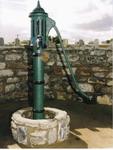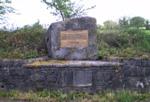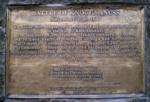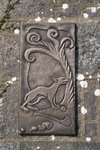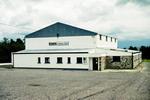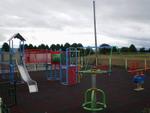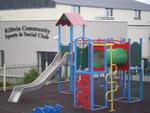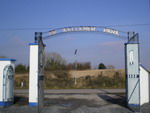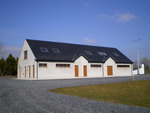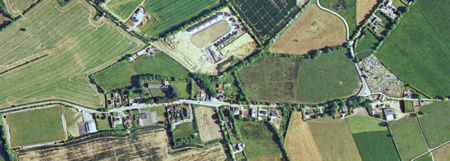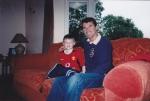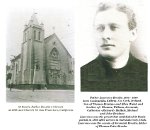St. John the Baptist Church.
Built in 1832 by Fr. Cornelius Scully
The stained glass memorial shown above was installed in the local Church to honour the late Father Michael Campbell.
Father Michael was the Curate in the parish of Ballyclough and Kilbrin from 2003 up to his death in 2016.
Ballyheen Piers
On the road from Buttervant to Kanturk, and about three miles from the latter; you will notice two piers, 6 m high and 80 m apart on the left hand side of the road. These are the much talked about Ballyheen Piers. On the top of each pier was a stone globe. They were built as the outer piers of an entrance to Rockfield House about 1750. Edward Badham Thornhill, landlord of Ballyheen had arranged to build a residence for his daughter there, but she had other ideas. She fell in love with the coachman and after a run away marriage lost all rights to the Ballyheen Estate. The mansion was never built.
At the base of one of the piers, the plaque pictured below was erected in memory of Alexander (or Alasdair) MacDonnell, who was killed after the battle of Knocknanuss in 1647.
You can read about Alexander MacDonnell and the battle of Knocknanuss here.
The Old Court
The Old Court is situated one mile south of Kanturk town, the capital of the ancient Barony of Duhallow. The Castle was built for McDonagh McCarthy, Lord of Duhallow. Read about the McDonagh McCarthys here.
Stained glass windows in St. John the Baptist Church, Kilbrin
Stone Head
To the right of the main entrance gate to the graveyard a female head is inserted in the wall. This head according to tradition was removed from the old Church.
Below, some photos of the graveyard as the evening shadows fall.
Grotto
The picture above was taken at the opening of the grotto back in 1954. Below are two more recent photos.
The plaque pictured above is erected inside the Church grounds in memory of Rev. Thomas Croke (Archbishop of Cashel and first patron of the GAA). Pictured below is the birthplace of Rev. Thomas Croke, located in the townland of Dromin. You can read about the history of the Croke family here.
The photo above was taken of the building of Dr. Croke Memorial Hall which was opened in 1952.
Below is a photo of the hall before it was demolished in 2008.
Pictured above is Ned Kelly's Cabin, better known locally as 'The Thatch Bar'. The picture was taken shortly after the pub was closed in 2000.
The first photo above of Castlecor House was taken in 1909 by Col. Grove White. The second photo was taken in 1993.
You can view the historical notes on Kilbrin parish by Col. Grove White here.
Scoil Eoin Baiste
Read about Scoil Eoin Baiste (Kilbrin National School) here.
The Village Pump in Kilbrin.
Pictured above is the Knocknanuss Monument at Abraham's Cross next to Glenlohane. The inscription on the plaque reads as follows:
BATTLE OF KNOCKNANUSS
November 13th. 1647
Opposite this plaque, to the North East, on private lands, is the hill of Knocknanuss. On this date, 8,200 troops of Irish Confederate Forces, led by Lord Taaffe of Corran, Co. Sligo and Sir Alasdair MacDonald of Colonsay, Scotland, engaged 5,200 troops of Parliamentary Forces led by Lord Inchequin of Thomond. Approximately 3,500 men were killed, making this battle the bloodiest of the Confederate Wars and the extended English Civil War.
"McDonagh future age shall see
A man of thy posterity
By whom the English Lord shall fall
Blood shall ascend to the legs small
In the place, we Cnoc na nOs do call"
a local prophesy
Erected by
THE CASTLEMAGNER HISTORICAL SOCIETY
1997
On either side of the entrance gates to the Church grounds in Kilbrin, you will notice the two brass plaques mounted on the piers. These are pictured above.
The plaque on the right shows an image of Rev. Thomas. Croke, the GAA crest and a bugle. The image of Rev. Thomas Croke and the GAA crest represents Kilbrin's association with Rev. Thomas Croke and with the GAA. Rev. Thomas Croke was born in in Kilbrin and was the first patron of the GAA. The bugle represents Kilbrin's association with the hunt.
The plaque on the left shows the “Hound of Culain” and an ash tree (which is the wood used to make hurleys). Again these represent Kilbrin's association with the GAA.
Kilbrin Community Centre
The photo above was taken in the year 2000. Below are some more recent photos.
The first picture above shows the entrance gates to Fr. Kelleher Park, Kilbrin's GAA grounds. Also pictured is the pitch itself, and the new dressing rooms that were built in 2009.
Given above is an aerial photo of Kilbrin village, which was taken back in 2005. (Clicking on the image, will give you a larger view of it).
Above are two old photos of pupils in Ballgraddy Boys School in 1924, and Curraghs N.S. In 1931. Names, where known, are listed in the photos.
'Keano' visits Kilbrin!
Roy Keane makes a surprise visit to his No. 1 fan, Michael Galvin, in 2004.
Both photos above were emailed to us by Tom Breslin (tombreslinsf@yahoo.com). The first photo is of his Great Great Grandfather, Jeremiah Brislane – Breslin. He was born in 1837 the son of Thomas Brislane and Elizabeth Carrol, from Coolnahilla. Jeremiah arrived in the New York area about 1860 and served in the Union Army in the American Civil War. The second photo is of Fr. Lawrence Breslin, Jeremiah's cousin (1st or 2nd). Lawrence was born on March 3rd, 1849, the youngest child of Thomas Brislane and Catherine Walsh. Lawrence was born at Coolnahilla, and schooled at Mt Melleray before entering All Hollows Seminary. He was ordained 24th of June 1873 for the San Francisco Diocese and worked in Salt Lake City before becoming the founding rector of St Paul's Parish in San Francisco. He died 27 Nov 1890.
